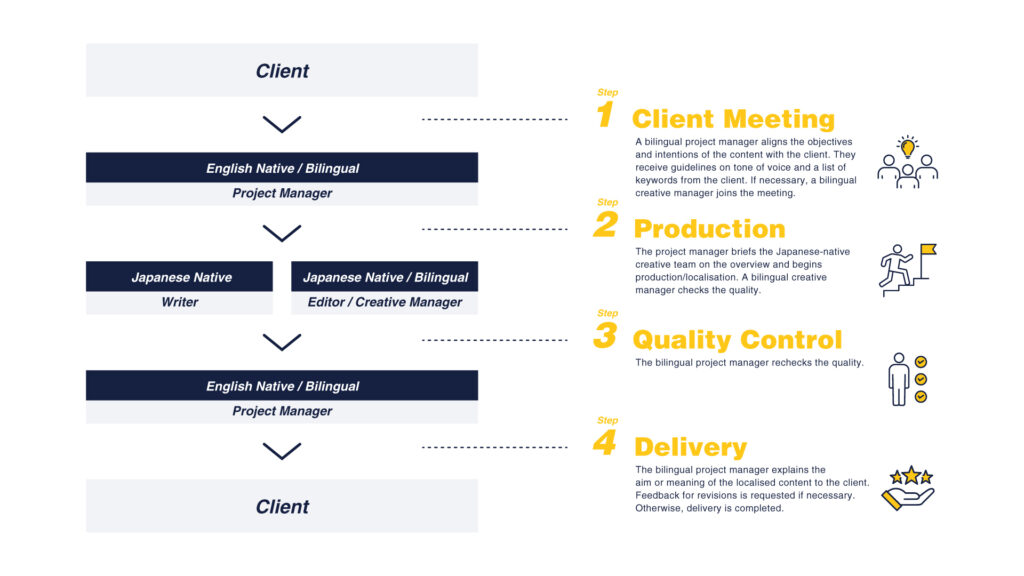How to localise written content

To localise content means taking content from one market and adapting it to fit - and be more suitable for - another. There’s an art to it and it’s crucial to understand that localisation goes way beyond translation. Advertising content, especially, often doesn’t have a direct translation and in order to expand globally, businesses need to understand the culture of their new market. (See our article on localisation pain points and solutions for a deeper dive on this.)
‘The word “translation” is more widely recognised’, says Anna, TAMLO’s Creative Lead, as she explains how the two services are often misunderstood. ‘Localise, localisation and transcreation are less commonly known and so it takes more of an effort to educate people on what it is and the process.’

To localise written content: TAMLO’s strategy and process
Any kind of media can be localised whether it’s video, graphics or text, but today, we’re focusing on the latter. Here at TAMLO, we work with a variety of written content from web copy, search ads copy, and social media to video subtitles, press releases and white papers.
Here’s our standardised localisation process:
- A bilingual project manager meets with the client to align the objectives and intentions of the content. They receive guidelines on tone and voice and a list of keywords from the client. If necessary, a bilingual creative manager joins the meeting.
- The project manager briefs the creative team and begins production/localisation. A bilingual creative manager checks the quality.
- The bilingual project manager rechecks the quality.
- The bilingual project manager explains the intent of the localised content to the client. Feedback for revisions is requested if necessary. Otherwise, the project is completed and delivered.
Beyond this, TAMLO’s copywriters and editors have their own individual processes. But we all agree that first and foremost it’s about understanding the client and the context of the content before localisation begins.
Localise: the importance of ground work
Yukie, TAMLO’s Editorial Manager, localises English content to the Japanese market and explains: ‘It’s crucial to know who is going to receive it, who the audience is and their level of knowledge of the topic because this will have a huge impact on how the content is localised. Otherwise it's just a pure translation and not a creative process.’
Anna, who localises content from Japanese to English, explains that next ‘it’s about knowing the client’s tone of voice and writing style. I go back and read reference articles and social media posts - whatever the project involves - check the glossary and regulations, and research similar articles in the industry.
‘It's also important to align with the client and find out what level of localisation they’re looking for. Some clients want more of a literal translation, whereas others want you to localise it completely so that it really resonates with the local audience.’
For pieces of written content provided by the client, Anna explains that she initially translates as is and then revisits, making tweaks where appropriate.
‘I go back several times and make sure that it makes sense and has the correct tone of voice for the particular audience that I'm localising it for. So if it's a British audience, and there are references to something specific in Japanese culture, I would provide an explanation in the text.’
Next, it’s editing and proofreading time: Anna highlights any areas that need a check from a project manager or Japanese native (correct terminology, understanding of the original text etc.) before one last check from the English creative team.
The localisation spectrum
How written content is localised also depends on the client’s industry and their stakeholders.
‘There’s a spectrum of localisation,’ says Anna. ‘Often, we get a lot of creative freedom from clients and there’s less direction - and that’s why they’re coming to TAMLO, because they trust our background and experience. Other times, the clients’ senior management teams want the translation done a certain way. For example, if it’s a super niche industry they likely don't want to stray too far from the original text and they might be strict about certain terminology.’
The challenges of localising written content
Localising content is also on a spectrum of ease. As writers and transcreators for a digital marketing agency, we will come up against topics that aren’t within our natural sphere of knowledge.
‘I’ve had to localise some very specific white papers before,’ laughs Anna. ‘Some of the language and topics were very intricate and involved a lot of industry jargon. In these instances, it’s about doing even more research and having a back-and-forth with the client to ensure the work is done accurately.
‘With this particular client they already had some translated content (to English) on their website but it wasn’t translated with the same meaning that I’d seen on other similar sites. So, because it’s a complicated topic, it was difficult to know whether to keep it the way they’d translated it (which wasn’t totally accurate) or to use what’s standard in the industry.
‘In the end, I went with the industry standard - a lot of our work at TAMLO is about using our discretion and pointing out discrepancies in content based on our experience and expertise. And that’s why people hire us as an agency.’
Beyond tricky topics
Niche and complicated subject matters aren’t the only challenge our writers face when localising written content.
‘If the client doesn't have a solid understanding of the goal of the project, their audience, style etc., that can make things difficult’, says Yukie. ‘It leaves it to us to fill in the gaps. In those instances, we take care to communicate as much as possible and to ensure our ideas and images are aligned.
Localising humour, short-form content like slogans, or concepts that only exist in that particular culture comes with its own unique set of challenges. It’s a whole new creative thought process as you begin to adapt something that’s catchy, for example, in English to the Japanese market. Essentially, you’re taking on the role of the client’s in-house copywriter/marketer.
‘You have to start from scratch’, says Anna, ‘and this is why it’s completely different to hiring a translation agency that doesn’t necessarily know about marketing. What we do is more creative.’
‘We're trying to maintain the nuances of the original text while simultaneously needing it to appeal in a new language and culture,’ explains Yukie. ‘Expressions can’t be translated directly and we’re having to find equivalents in the new language without changing the layout or structure too much. It’s difficult and takes a lot of thinking time. This is particularly true when we localise subtitles. The word order of Japanese and English is significantly different, so it’s not uncommon to think about various ways to make it flow naturally.’
‘A fun and creative process’
Localising written content isn’t easy, but, as our creative writers know well, there is beauty in pain. And we’re always proud of, and excited by the end result.
‘It’s such a fun and creative process’, says Anna. ‘You start with an idea, progress it into a bunch of ideas, sort through those, make new versions from the bits you like and then refine until you’re happy. I get immense satisfaction out of making small tweaks that make a huge difference (often in terms of the user experience on a website). And when the client’s happy, well, that’s very rewarding.’
As a cross-cultural team working in transcreation, being culture curious is in our DNA.
Yukie, who originally studied linguistics, finds that learning more about each culture as she works in English and Japanese is a happy by-product of the job: ‘I like learning about, and working with people from different backgrounds. But I think everyone at TAMLO shares that mentality.’
We come from a mix of backgrounds linguistically, but we all have some kind of cross-cultural connection and/or have insights and expertise that are crucial for the projects we work on.





